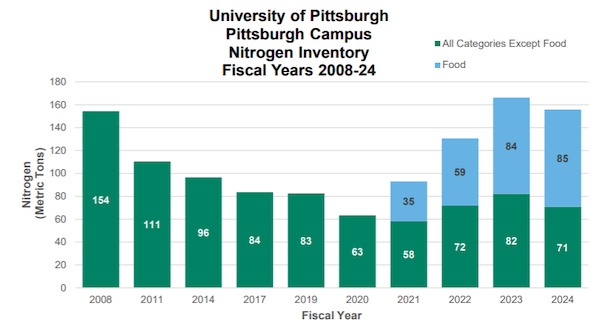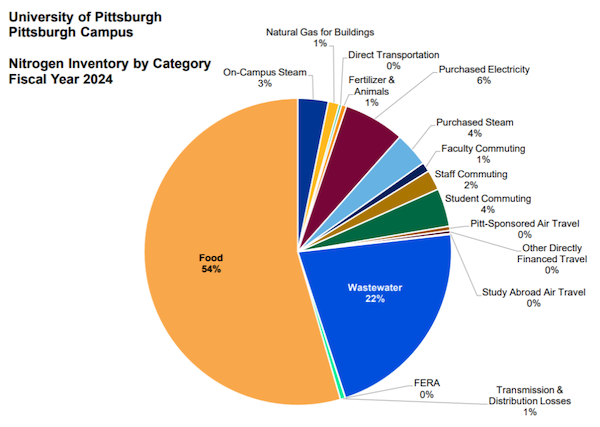What is nitrogen?
Nitrogen is one of the most common elements here on Earth. Its presence in our atmosphere makes the sky blue, it helps make soils fertile for plants to grow and forms the foundations of proteins found in a healthy human body. However, excess nitrogen introduced into ecosystems in a reactive form is problematic.
Why do we care about nitrogen?
Reactive nitrogen in the environment can have adverse effects on the environment and human health by causing smog, toxic algae blooms, acid rain, and biodiversity loss. Nitrogen is also a key contributor to climate change. When active nitrogen is exposed to soil (such as in fertilizers), microbial reactions take place that generate nitrous oxide. Nitrous oxide has a warming potential 300 times greater than carbon dioxide as a greenhouse gas. Another major source of nitrogen emissions is the combustion of fossil fuels for heating and electrical generation.
How do we measure nitrogen?
A nitrogen inventory measures how much reactive nitrogen is released into the environment by an organization and can help identify ways to reduce nitrogen emissions. Pitt uses the Sustainability Indicator Management and Analysis Platform (SIMAP) to calculate its nitrogen footprint, which measures the amount of reactive nitrogen released to the environment from a campus’s resource consumption. Examples of reactive nitrogen include water pollutants such as nitrate and ammonium, air quality pollutants like ammonia and nitrogen oxides, and the greenhouse gas nitrous oxide.
According to SIMAP, “Reactive nitrogen can result from everyday activities like food service, energy use, transportation, and ground fertilizer. Reducing your nitrogen footprint can provide benefits to air quality, water quality, and climate change.”
What is Pitt’s nitrogen footprint?
The University of Pittsburgh has been calculating and reporting on its nitrogen footprint since fiscal year (FY) 2019 as part of the annual greenhouse gas inventorying process. For FY24, Pitt’s net nitrogen footprint totaled 155.76 metric tons, a 6.3% decrease from FY23. This is primarily due to decreases in the categories of wastewater, purchased electricity, and Pitt-sponsored travel.

As shown in the graph above, the primary source of nitrogen for the University of Pittsburgh is food which contributed to the release of 85 MT of nitrogen in FY24 and accounted for 54% of the campus’s nitrogen footprint. The second largest contributor to Pitt’s nitrogen emissions is wastewater, which accounted for 22%, as you can see below.
The category with the largest increase between FY23 and FY24 was student commuting, which grew from 1% to 4% of the inventory. This reflects the growth of Pitt’s student population. That makes it even more notable that overall nitrogen emissions still decreased by 6.3% in FY24.

How can you help reduce nitrogen emissions?
You can play an important role in reducing nitrogen emissions by doing the following:
- Reduce your food waste by taking only what you can eat and arranging for food recovery at catered events.
- Eat a plant forward diet and make event menus vegetarian or vegan.
- Reduce wastewater by turning off faucets between uses and reporting leaks or running toilets to Facilities Management.
- If living in a residence hall, reduce waste water by taking shorter showers and only doing full loads of laundry.
Read the full FY24 Nitrogen Inventory for the University’s Pittsburgh campus, and for comparison, check out FY23 Nitrogen Inventory.
All Nitrogen Inventories for the Pittsburgh campus are available under Commitments & Reports.
